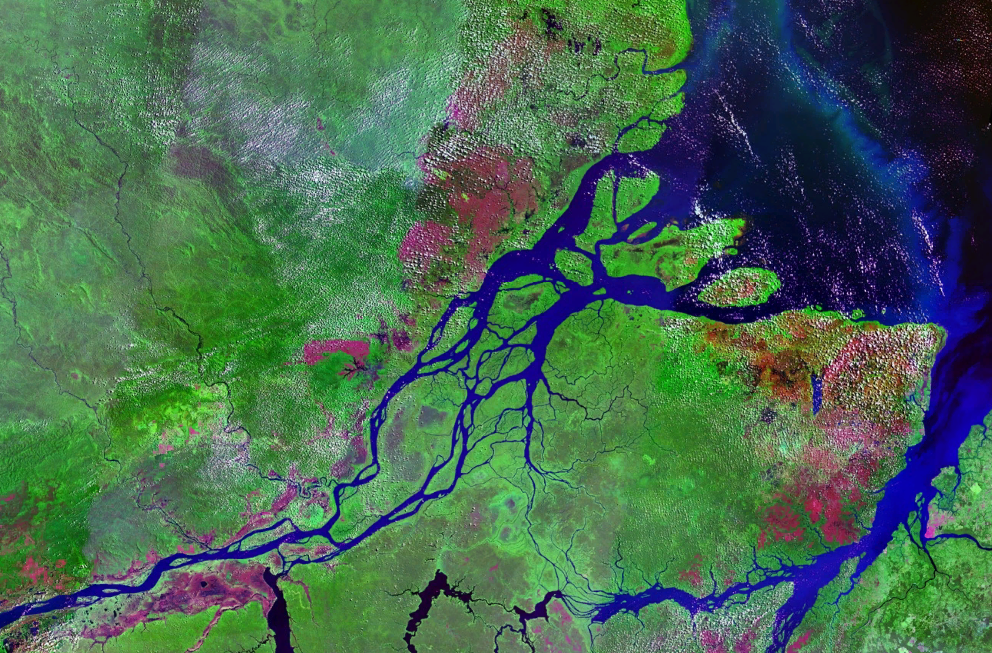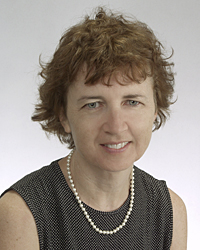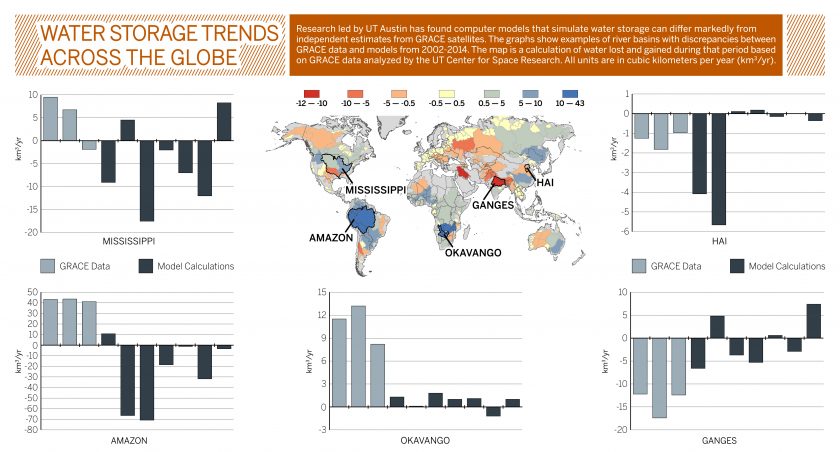Research Finds Discrepancies Between Satellite and Global Model Estimates of Land Water Storage
January 22, 2018

Research led by The University of Texas at Austin has found that calculations of water storage in many river basins from commonly used global computer models differ markedly from independent storage estimates from GRACE satellites.

The findings, published in the Proceedings of the National Academy of Sciences on Jan. 22, raise questions about global models that have been used in recent years to help assess water resources and potentially influence management decisions.
The study used measurements from GRACE satellites from 2002 to 2014 to determine water storage changes in 186 river basins around the world and compared the results with simulations made by seven commonly used models.
The GRACE satellites, operated by NASA and the German Aerospace Center, measure changes in the force of gravity across the Earth, a value influenced by changes in water storage in an area. The computer models used by government agencies and universities were developed to assess historical and/or scenario-based fluxes in the hydrological cycle, such as stream flow, evapotranspiration and storage changes, including soil moisture and groundwater.
“People are depending more and more on global models to determine projections of the impacts of human water use and climate on water resources,” said lead author Bridget Scanlon, a senior research scientist at the university’s Bureau of Economic Geology. “We are now able to evaluate water storage changes from models with GRACE data, which suggests that the models may underestimate large water storage changes, both large declining and rising storage trends.”
For example, in the Amazon River basin, GRACE data indicate that water storage increased by 41 to 43 cubic kilometers during the study period — the largest increase in water storage of any basin in the world. But most of the models projected huge declines in water storage, with one simulating a loss of 70 cubic kilometers. The model that most closely matched the GRACE data calculated an increase of only 11 cubic kilometers.
In the Ganges River basin, GRACE showed a loss of 12 to 17 cubic kilometers of water per year over the 12-year period — the biggest decrease in water storage measured by the study. The models range between a loss of 7 cubic kilometers and an increase of 7 cubic kilometers.

Overall, the model results calculated a decline in global water storage during the study period, while GRACE data indicate it was on the rise. However, the study notes that while the climate increased water storage globally, humans caused significant declines in certain regions. The study area covered about 63 percent of global land area and excluded Greenland and Antarctica because most of the water in those areas is trapped in glaciers or ice sheets.
The study shows that there are regions where global models need to be improved, said co-author Hannes Müller Schmied, a senior research scientist at Goethe University Frankfurt. The global perspective of the research can help scientists understand why models are performing better in some areas than others, and zero-in on the areas where they’re not matching up with the data.
“Based on the comprehensive assessment of water storage changes, we have important additional information and can now focus on challenging regions and analyze more in-depth which processes need to be included, for example floodplain dynamics and backwater effects in the Amazon, or to be improved upon, like human water extractions in the Ganges River basin,” Müller Schmied said.
The study also notes that scientists should work on improving regional assessments.
“GRACE is great because it highlights the global picture of what’s happening with global water storage, and at a coarse grid-scale it’s really nice to see what’s happening,” Scanlon said. “But ensuring water availability for human consumption and agriculture is in many cases a regional to local issue, and we should put increased emphasis on analyses at this scale by, for example, integrating local data. The specific situation could be much better investigated than with global-scale studies only.”
The team included additional researchers from UT Austin’s Bureau of Economic Geology and Center for Space Research, Utrecht University (The Netherlands), NASA’s Jet Propulsion Laboratory, Tsinghua University (China), and the University of Rennes (France). The bureau is a research unit of the Jackson School of Geosciences.
The study was funded by the Jackson School of Geosciences.
For more information, contact: Anton Caputo, Jackson School of Geosciences, 512-232-9623; Monica Kortsha, Jackson School of Geosciences, 512-471-2241
